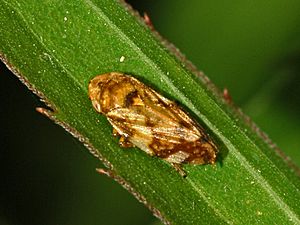Aphrophoridae facts for kids
Quick facts for kids Aphrophoridae |
|
|---|---|
 |
|
| Philaenus spumarius | |
| Scientific classification |
|
| Kingdom: | Animalia |
| Phylum: | Arthropoda |
| Class: | Insecta |
| Order: | Hemiptera |
| Superfamily: | Cercopoidea |
| Family: | Aphrophoridae Amyot & Serville, 1843 |
| Diversity | |
| at least 150 genera | |
The Aphrophoridae, commonly known as spittlebugs, are small insects that are famous for the bubbly, white foam they create on plants. This foam looks a bit like spit, which is how they got their name! Spittlebugs are not beetles; they are actually a type of "true bug" belonging to the order Hemiptera. They are related to cicadas and leafhoppers.
Spittlebugs are usually harmless to plants. They only become a problem if there are a huge number of them on one plant.
Contents
What Are Spittlebugs?
Spittlebugs are small insects, usually only a few millimeters long. They can be green, brown, or black, and often blend in with the plants they live on. They have strong legs that allow them to jump very well, which is why they are also sometimes called "froghoppers."
These insects get their food by sucking sap from plants. They have a special mouthpart, like a tiny straw, that they use to pierce plant stems and leaves.
The Amazing Spittle
The most unique thing about spittlebugs is the foamy "spittle" they produce. This foam is made by the young spittlebugs, called nymphs. Here's how they make it:
- The nymph sucks a lot of sap from a plant.
- It then mixes the sap with air and a special sticky substance from its body.
- It blows bubbles with its tail end, creating the foamy mass.
The spittle serves several important purposes for the nymph:
- Protection: It hides the nymph from predators like birds and other insects.
- Moisture: It keeps the nymph from drying out, especially on hot days.
- Temperature control: It helps keep the nymph cool.
Life Cycle of a Spittlebug
Spittlebugs go through a few stages in their lives:
- Eggs: Adult female spittlebugs lay their eggs in the fall, usually on plant stems or leaves.
- Nymphs: The eggs hatch in the spring. The tiny nymphs immediately start feeding on plants and creating their protective spittle. They stay inside this foam as they grow, shedding their skin several times.
- Adults: After about a month, the nymphs become adult spittlebugs. Adults no longer produce spittle. They are free to jump and fly to find new plants and mates.
Spittlebugs and Plants
Spittlebugs live on a wide variety of plants, including grasses, weeds, and garden plants. They are found all over the world.
Are Spittlebugs Harmful?
For most gardeners and farmers, spittlebugs are not a big concern.
- They usually don't cause much damage to plants.
- The foam might look a bit messy, but it doesn't harm the plant itself.
- Sometimes, if there are many spittlebugs on one plant, they might cause the leaves to curl or grow a bit slower. This is rare and usually not serious.
If you see spittle on your plants, you can often just rinse it off with water.
Images for kids
See also
 In Spanish: Aphrophoridae para niños
In Spanish: Aphrophoridae para niños




